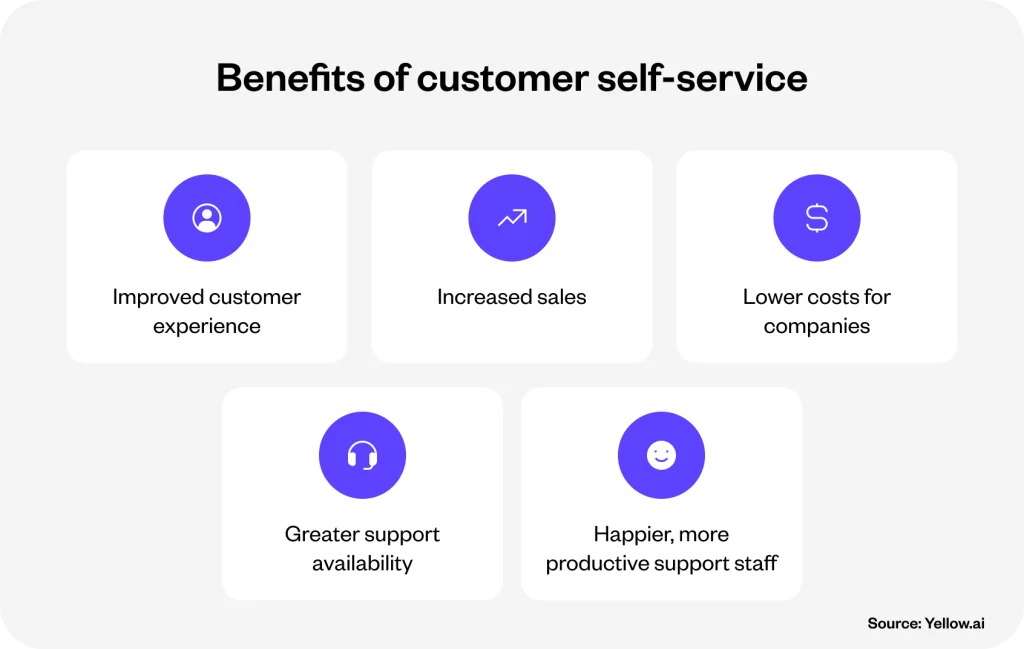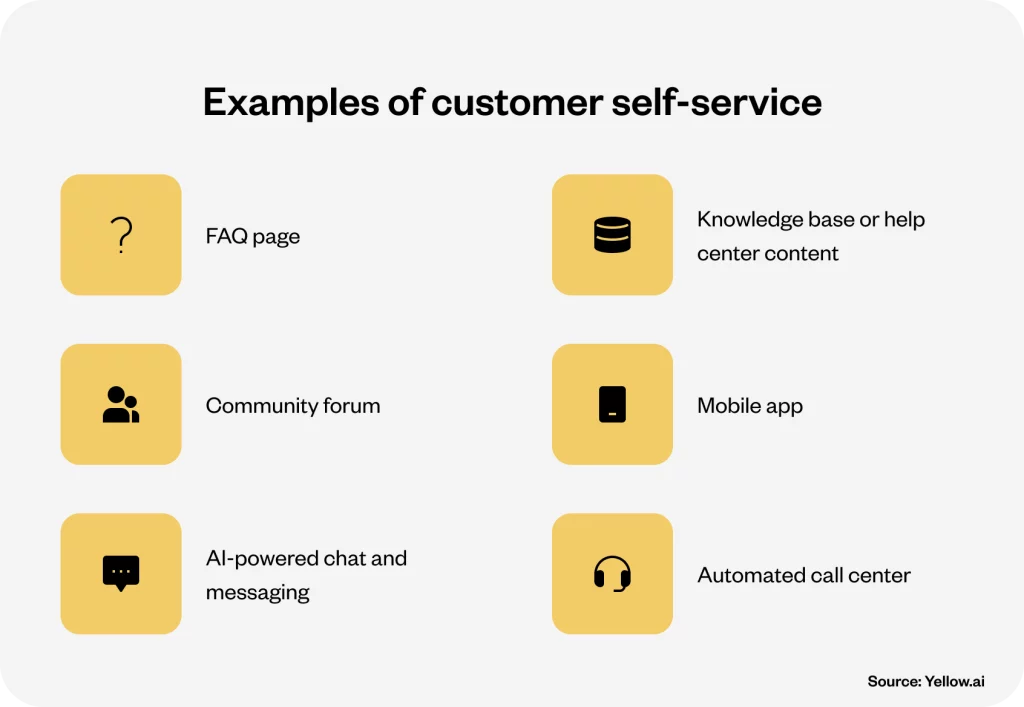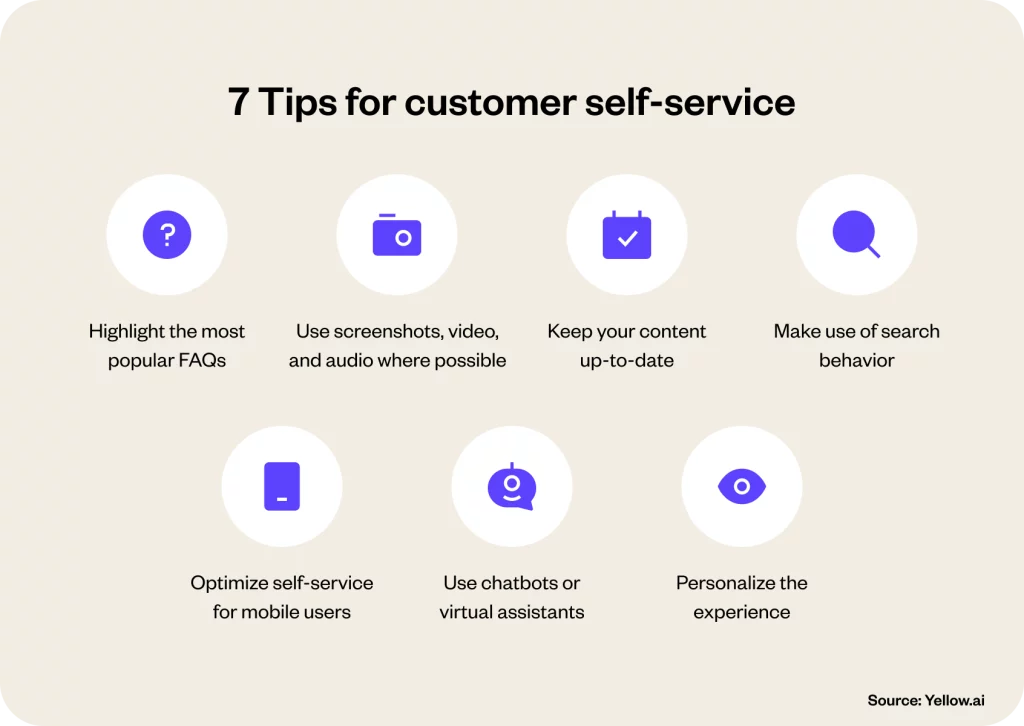Executive summary
Discover the transformative world of self customer service in this comprehensive guide. In the age of immediate gratification, businesses are rapidly adopting customer self-service methods to enhance customer experience and efficiency. This article delves into what customer self-service is and its pivotal role in today’s digital landscape. We cover various facets, including self customer support, the benefits of a self-service customer support system, and effective strategies for self-service. By embracing this innovative approach, companies can achieve improved customer satisfaction, increased sales, lower operational costs, and heightened support availability, all while empowering their support staff.
Gone are the days when customers would patiently wait on hold to get their queries answered. Time is a currency more valuable than ever in this fast-paced digital world. A typical customer of today epitomizes the new-age consumer. The customer doesn’t want to wait for email responses or navigate through automated phone menus. They want answers now, and they prefer getting them on their terms. That is where self customer service becomes not just a handy tool but a vital part of a customer’s interaction with your business.
Picture this: Joe visits your website at midnight, looking for a quick fix to a product issue. He doesn’t reach for the phone to call customer support; instead, he finds his answer in an easy-to-navigate FAQ section. This scenario is increasingly common and underscores a seismic shift in customer service dynamics. Self-service options aren’t just a neat addition to your customer service toolkit; they’re a must-have feature that resonates with customers like Joe, who value speed, autonomy, and efficiency. In a world where 90% of customers globally expect an online self-service portal, as per Microsoft’s report, it’s clear that empowering customers isn’t just a trend – it’s a strategic necessity to keep them engaged and satisfied.
What is customer self-service?
Customer self-service is emerging as the cornerstone of contemporary customer experience. At its essence, customer self-service is an empowered approach that allows customers to find answers and resolve their queries independently, without direct interaction with customer service agents. This innovative strategy encompasses various tools and platforms where information and services are accessible 24/7, catering to the autonomous and tech-savvy customers of today.
Envision a scenario where customers like Joe, who visited your site at midnight, can effortlessly navigate through a well-structured FAQ section, watch tutorial videos, or interact with AI-driven chatbots to resolve their issues. This level of autonomy not only caters to the customers’ preference for immediate and hassle-free solutions but also reflects a profound shift in how businesses approach customer support.
The evolution of customer self-service extends to several digital channels – from comprehensive knowledge bases and intuitive customer portals to interactive community forums. These platforms are meticulously designed to provide instant access to information, enabling customers to perform a variety of tasks ranging from troubleshooting a product to updating account information, all at their convenience.
The impact of this self-service paradigm is twofold. For customers, it translates to an unparalleled level of convenience and speed, aligning perfectly with the modern customer’s expectations for on-demand support. About 65% of customers, according to Salesforce’s “State of Service” report from December 2020, prefer using self-service channels for simple matters, indicating a clear preference for this mode of service.
For businesses, the benefits are equally compelling. By providing effective self-service options, companies can significantly reduce the volume of cases reaching their call centers. This reduction, as observed by 66% of service professionals in the same Salesforce report, not only lowers operational costs but also frees up agents to focus on more complex and nuanced customer issues. This shift allows for a more efficient allocation of resources, leading to a leaner, more responsive customer service operation.
Self-service is becoming the first choice
The paradigm of customer service is undergoing a significant transformation, evolving towards a preference for self-service solutions. The rapid shift towards digital solutions has made self-service the go-to option for consumers seeking quick and efficient answers. Today, a staggering 40% of consumers express a preference for self-service over direct human contact when it comes to addressing their support needs. This preference underscores a broader trend in consumer behavior, where independence and speed are valued above traditional customer support methods.
A comprehensive study by Dimension Data reveals that an overwhelming 73% of customers prefer to use a company’s website for support, surpassing other channels like social media, SMS, and live chat. This inclination towards web-based self-service options reflects a profound change in customer expectations. When encountering a product or service issue, customers’ instinctive response is increasingly to seek solutions online. They gravitate towards easily accessible online resources such as FAQ articles, how-to videos, and comprehensive knowledge bases.
This shift in consumer behavior has not gone unnoticed by businesses. In response, companies are rapidly deploying self-service solutions, recognizing them as an essential element of customer service strategy. However, it’s critical to note that the effectiveness of these self-service portals hinges on their usability. Surprisingly, despite the growing demand for self-service options, about 55% of customers find many web self-service portals challenging to navigate. This statistic highlights a crucial gap in the self-service experience – ease of use.
Real-time support at scale with generative AI

Benefits of customer self-service
Customer self-service is not just a modern convenience; it’s a strategic asset that brings multifaceted benefits to businesses and customers alike. Let’s explore these benefits in detail:

1. Improved customer experience
Today’s consumers value autonomy and efficiency. According to research across industries, a staggering 81% of customers try to resolve issues on their own before contacting a live representative. By implementing self-service, businesses empower customers to find solutions at their own pace and convenience. This empowerment enhances the overall customer experience, as customers appreciate the ability to access information and resolve problems without the need for direct human intervention.
An effective self-service system is characterized by intuitive navigation, comprehensive information, and accessibility, all of which contribute to a more satisfying and efficient customer journey.
2. Increased sales
The impact of self-service on sales is significant. Data reveals that 53% of U.S. online adults are likely to abandon their online purchases if they can’t find quick answers to their questions. Self-service options like detailed product guides, FAQs, and troubleshooting information directly address this issue, providing customers with immediate assistance.
This immediate access to information not only helps in retaining customers who might otherwise leave but also enhances the likelihood of conversions, as customers feel more confident and informed about their purchases.
3. Lower costs for companies
From a financial perspective, self-service is a game-changer. The cost of a self-service transaction is just a fraction of that of a live interaction, with live service interactions costing over $7 for B2C companies and more than $13 for B2B companies.
By diverting routine inquiries to self-service channels, businesses can drastically reduce the volume of calls and messages to customer service centers, leading to substantial cost savings. This reduction in live interactions allows companies to allocate resources more efficiently, investing in areas that require more specialized attention.
4. Greater support availability
Self-service tools extend the availability of support far beyond regular business hours. Unlike human-powered support, which is limited by working hours and availability, self-service platforms like knowledge bases, forums, and automated chatbots offer round-the-clock assistance. This 24/7 availability is particularly crucial in today’s global marketplace, where customers from different time zones require consistent and reliable access to support.
5. Happier, more productive support staff
The role of self-service in enhancing staff satisfaction and productivity is often overlooked. Studies indicate that about 40% of customer tickets are repetitive and mundane, which can lead to decreased job satisfaction among support staff.
By automating these repetitive queries through self-service, businesses can reduce the burden on their support teams, allowing them to focus on more complex and engaging tasks. This shift not only boosts the morale of the support staff but also increases their efficiency and effectiveness in handling intricate customer issues.
Good self-service vs. Bad self-service
In customer self-service, not every approach yields the same results. While a well-implemented self-service can elevate customer experience and operational efficiency, a poorly executed one can lead to frustration and dissatisfaction. Let’s compare the hallmarks of good and bad self-service.
| Aspect | Poor self-service | Effective self-service |
| Customer effort | Forces customers to do unnecessary work, creating inefficiencies. | Enables efficient, quick access to information, reducing customer effort. |
| Problem-solving | Makes customers find workarounds for product or process issues. | Directly addresses and resolves customer queries or problems. |
| Technology use | Utilizes complicated, frustrating technology that hinders user experience. | Employs user-friendly technology that enhances the self-service experience. |
| Human support access | Obstructs or complicates the transition to human support when needed. | Provides a clear, easy pathway to human support for complex issues. |
| Customer control | Limits customer’s ability to control their experience or make changes independently. | Empowers customers with control over their experience and account settings. |
| Staff utilization | Leads to inefficient use of customer service staff for routine tasks. | Frees up staff for complex queries, enhancing overall service quality and staff job satisfaction. |
| Customer experience | Results in customer frustration and dissatisfaction. | Boosts customer satisfaction through autonomy, efficiency, and effective problem resolution. |
Good self-service is characterized by its efficiency, user-friendliness, and ability to empower both customers and staff. Bad self-service, in contrast, creates more hurdles than solutions, leading to customer frustration and operational inefficiencies. For businesses, the focus should be on designing self-service systems that are intuitive, helpful, and seamlessly integrated with other customer support channels.
Related must read: Customer experience vs. customer service
Examples of customer self-service
As the digital age evolves, businesses are incorporating diverse self-service options to meet customer needs for quick and accessible support. These tools not only alleviate ticket volumes but also provide customers with the convenience of round-the-clock assistance. Let’s explore some effective examples of customer self-service:

1. FAQ page
A well-crafted Frequently Asked Questions (FAQ) page serves as the first line of support for customers. It’s where commonly asked queries, like return policies or billing processes, are succinctly answered. An effective FAQ page is both concise and comprehensive, often linking to more detailed resources like a knowledge base or contact information for further assistance.
Example: An online retail company could have an FAQ section covering topics like shipping duration, return policies, and payment options. For instance, a question like “How can I track my order?” could be answered with a brief explanation and a link to the order tracking page.
2. Knowledge base or help center content
An AI-powered knowledge base empowers customers to find detailed solutions without the need to contact support directly. Whether accessed through a company’s website, search engines, or a mobile app, a robust knowledge base is essential for providing in-depth information on various topics related to your products or services.
Example: A software company might offer a comprehensive knowledge base that includes detailed tutorials on using its products, troubleshooting guides, and tips for optimizing performance.
3. Community forum
Community forums create a space where customers can interact with each other, share experiences, and offer solutions. Managed by the company, these forums can be integrated into the knowledge base or exist as a separate entity on the website. They harness the collective knowledge and experience of the user community, often uncovering unique insights and practical workarounds.
Example: A consumer electronics brand could host a forum where users discuss product features, share tips on usage, and help each other with troubleshooting. For example, a thread could be dedicated to optimizing battery life for a specific device model.
4. Mobile app
Mobile apps can significantly enhance customer self-service by offering instant access to support features. Through an app, customers can perform actions like modifying orders, accessing account information, or reporting issues, all within a few taps on their mobile devices.
Example: A banking app that allows customers to check balances, transfer funds, and even temporarily block a lost card without having to call customer service.
5. AI-powered chat and messaging
AI-driven chatbots and messaging services are revolutionizing customer support. These tools are available on websites, mobile apps, and popular messaging platforms, providing immediate responses to customer queries. They effectively scale support operations while allowing human agents to focus on more complex interactions.
Example: An e-commerce site could use a chatbot that helps customers find products, answer FAQs about sizing and shipping, and guide them through the checkout process.
6. Automated call center
Interactive voice response (IVR) systems in automated call centers enable customers to resolve queries through voice commands or keypad inputs. These systems can provide answers to FAQs, assist in order processing, and route calls to appropriate departments, all without the need for direct human intervention.
Example: A utility company’s IVR system could let customers report outages, submit meter readings, or pay bills over the phone without speaking to an agent.
7 tips for customer self-service
The difference between a satisfactory and an outstanding self-service experience often lies in the details. Whether it’s a small online business or a large corporation, the effectiveness of a self-service system can be significantly enhanced with a few strategic enhancements. Let’s explore seven crucial tips that can transform your customer self-service from good to exceptional, ensuring it meets the demands of today’s digitally savvy consumers.

1. Highlight the most popular FAQs
To make your self-service portal a go-to resource, prioritize showcasing the most frequently asked questions. This approach directly addresses common customer queries, such as password resets or account management issues, making it easier for users to find solutions. Featuring these FAQs prominently on your portal’s homepage can significantly enhance user experience and reduce the need for direct contact with support staff.
2. Use screenshots, video, and audio where possible
Visual aids like screenshots and videos can significantly enhance the effectiveness of your self-service content. They offer a more engaging and clearer way to guide customers through processes or troubleshoot issues. For example, a step-by-step video tutorial can be more effective than text instructions for complex tasks.
3. Keep your content up-to-date
An effective self-service portal requires continuous content updates and improvements. Outdated information can lead to customer frustration and mistrust. Regularly revising and updating your knowledge base, FAQs, and tutorials ensures that customers always have access to the most current and relevant information.
4. Make use of search behavior
A user-friendly and efficient search function is crucial in a self-service portal. Customers expect to find answers quickly, and a well-optimized search feature can significantly enhance their experience. Analyzing search behaviors and patterns can help in fine-tuning the search functionality to deliver more accurate and relevant results.
5. Optimize self-service for mobile users
In today’s mobile-centric world, it’s essential to optimize your self-service portal for mobile devices. A mobile-friendly interface ensures that customers can access support anytime, anywhere, aligning with their on-the-go lifestyle. This accessibility can dramatically improve the user experience and encourage more frequent use of the self-service options.
6. Use chatbots or virtual assistants
Incorporating AI-driven chatbots or virtual assistants into your self-service portal can provide immediate, automated responses to common queries. These tools efficiently handle routine tasks such as password resets or order status checks, allowing your customer service team to focus on more complex issues.
7. Personalize the experience
Personalization is key to creating a memorable self-service experience. Utilizing customer data to tailor the self-service portal to individual needs and preferences can significantly enhance satisfaction. Personalized content, such as product recommendations or service updates relevant to the customer’s history, makes the self-service experience more relevant and engaging.
The business value of customer self-service
Customer self-service is not just a convenience—it’s a strategic asset that holds significant value for businesses. The integration of self-service portals and tools into customer service models does more than just streamline customer interactions; it directly impacts a company’s bottom line.
Forrester Research and Oracle‘s in-depth analysis reveals that web self-service can potentially reduce business costs by approximately $11 per customer interaction. When extrapolated over thousands of customer interactions each year, the financial benefits are substantial. For instance, a company handling 3,000 calls per week could potentially save up to $1.7 million annually by leveraging self-service options. These figures are more than just theoretical savings; they represent real financial opportunities that businesses can capitalize on.
The investment required for setting up a self-service portal is often perceived as a barrier. However, the reality is quite the contrary. Compared to the costs associated with traditional customer support channels, setting up self-service platforms is considerably less expensive and offers a higher return on investment.
Research by Accenture highlights that implementing self-service systems can lead to annual savings of $1-3 million for companies. This cost-effectiveness, coupled with enhanced customer satisfaction and operational efficiency, makes customer self-service an indispensable tool in the modern business environment. By adopting these platforms, companies not only reduce their operational expenses but also position themselves to meet the evolving demands of the digital customer, thereby securing a competitive edge in the market.
How Yellow.ai can help you build an AI chatbot for enhanced customer self-service
When you think of self-service customer support, AI chatbots have emerged as a game-changing technology, and Yellow.ai stands at the forefront of this innovation. Yellow.ai specializes in developing sophisticated AI chatbots that are not only intelligent but also intuitively align with your business needs and customer expectations. Here’s how Yellow.ai can revolutionize your customer self-service experience:
Customizable AI chatbots: Yellow.ai offers fully customizable chatbots that can be tailored to suit the specific requirements of your business. Whether it’s handling customer inquiries, providing product information, or facilitating transactions, these chatbots are equipped to manage a wide range of tasks efficiently.
24/7 availability: With Yellow.ai’s AI chatbots, businesses can offer round-the-clock customer service. It ensures that your customers receive immediate assistance at any time of the day, significantly enhancing customer satisfaction and engagement.
Natural Language Processing (NLP): These chatbots are powered by advanced natural language processing (NLP) capabilities. It means they can understand and respond to customer queries in a natural, conversational manner, making interactions more human-like and engaging.
Seamless integration with multiple platforms: Yellow.ai’s chatbots can be seamlessly integrated into various digital platforms, including websites, mobile apps, and social media channels. This multi-platform integration allows businesses to provide a consistent self-service experience across different customer touchpoints.
Real-time analytics and insights: Gain valuable insights into customer preferences and behavior with Yellow.ai’s real-time analytics. This data can help businesses make informed decisions to improve their services and personalize customer interactions.
Scalability: As your business grows, Yellow.ai’s chatbots can easily scale to handle increased volumes of customer interactions without compromising on quality or efficiency.
Automated and personalized responses: These chatbots are capable of providing automated responses to common queries while also offering personalized recommendations based on customer history and preferences.
User-friendly interface: Yellow.ai prioritizes user experience, ensuring that the chatbots have an intuitive and easy-to-navigate interface for both customers and business operators.
Continuous learning and improvement: Leveraging AI and MML, Yellow.ai’s chatbots continuously learn from interactions to improve their responses and effectiveness over time.
Compliance and security: Adhering to the highest standards of data security and compliance, Yellow.ai ensures that all customer interactions and information are handled with utmost confidentiality and integrity.
By partnering with Yellow.ai, businesses can not only enhance their customer self-service capabilities but also streamline their operations, reduce costs, and drive sales.
Interested in elevating your customer service experience with AI-driven solutions? Book a demo with Yellow.ai today and embark on a journey towards digital excellence in customer service.
Real-time support at scale with generative AI

Conclusion: Empowering your business with customer self-service
We are witnessing a transformative shift in the customer service landscape. This evolution is not just about integrating new technologies; it’s about reimagining the very essence of customer interactions. In this digital age, where autonomy and efficiency are paramount, self-service emerges as a beacon of modern customer experience – one that empowers customers and businesses alike. It’s an era where customer convenience and business efficiency merge, paving the way for a more dynamic, responsive, and cost-effective approach to customer service. Embrace this change, and your business will be positioned to thrive in the ever-evolving world of customer service.
Frequently asked questions
What is customer service self-service?
Customer service self-service refers to the practice of empowering customers to find solutions and complete tasks independently without the direct aid of customer service agents. This approach leverages digital tools and platforms, such as AI-powered chatbots, FAQ pages, and knowledge bases, to provide 24/7 access to information and services. It caters to the modern consumer’s preference for quick, convenient, and autonomous problem-solving.
What are the types of customer self-service?
Various types of customer self-service include FAQ pages, knowledge bases, community forums, mobile apps, AI-powered chat and messaging, and automated call centers. Each of these platforms serves a unique role in facilitating customer autonomy, offering diverse ways for customers to access information, perform tasks, and resolve issues on their terms.
What is the most successful example of self-service?
A prominent example of successful self-service is the implementation of AI-powered chatbots on websites and mobile apps. These chatbots provide instant responses to customer inquiries, guide users through various processes, and offer personalized assistance, thereby enhancing customer experience while reducing the workload on human customer service agents.
What are the benefits of self-service in a call center?
Self-service in call centers offers numerous benefits, including reduced call volumes, lower operational costs, and improved customer satisfaction. By enabling customers to find answers through automated systems like IVR (Interactive Voice Response), businesses can allocate their human resources more efficiently, focusing on complex queries that require a personal touch.
How do you offer self-service to customers?
To offer self-service to customers, businesses should integrate various digital tools into their customer service model. This integration includes setting up comprehensive FAQ sections, developing an accessible knowledge base, implementing AI-powered chatbots, and ensuring mobile app functionality. It’s also crucial to maintain these resources with up-to-date information and user-friendly interfaces to enhance the overall customer experience.






















